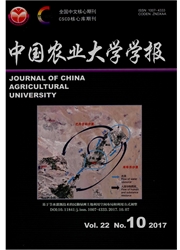

 中文摘要:
中文摘要:
为探讨平谷区在不同高程、坡度和坡向分级的土地利用变化规律,为土地资源可持续利用和管理决策提供依据,以北京市平谷区为例,借助DEM提取地形信息,对平谷区土地利用变化在各地形因子分级的分布特征进行分析,结果表明:1)平谷区的土地利用类型以耕地、园地和林地为主,1993—2008年的15年间,平谷区耕地面积大幅度减少,园地、居民点及工矿和交通用地面积明显增加;2)平谷区的土地利用变化在不同高程、坡度和坡向分级差异明显。耕地、居民点及工矿用地、交通用地的转化主要发生在0~300m高程带和小于15°的坡度带,林地与草地的互转主要发生在高程300~800m、坡度大于8°的阳坡与半阳坡;园地与草地的转化主要发生在高程0~300m、坡度在2~25°的半阳坡;园地与林地的转化主要发生在高程0~800m、坡度2~25°的阳坡与半阳坡,高程大于800m、坡度大于25°的区域主要是林地向其他地类的转化;3)平谷区的土地利用变化剧烈且与高程、坡度和坡向具有高度相关性,低高程和低坡度区域内主要表现为建设用地和园地增加以及耕地流失。随着高程、坡度增大,土地利用变化逐渐减弱。
 英文摘要:
英文摘要:
Topography is the basis for land use spatial pattern formation. This study analyzed the land use structure of Pinggu District from 1993 to 2008 and the land use change on the different classification of elevation, slope and slope direction. The results showed thatarable land, orchard, woodland were the main land use type of Pinggu District. The arable land decreased but both orchardand construction land increased. The land use change was significantly different between different classifications of elevation, slope and slope direction. Most conversions between arable and construction land occurred in the place with an elevation less than 300 meters and the slope lower than 15 degree. The conversion between woodland and grassland was mostly taken place in the sunny slope and semi-sunny slope,with the elevation between 300 to 800 meters and the slope lower than 8 degree. The conversion between orchard and grassland was mostly taken place in the semi-sunny slope, the elevation less than 300 meters and the slope between 2 to 25 degrees. The conversion between orchard and woodland was usually taken place in the semi-sunny slope, the elevation less than 800 meters and the slope between 2 to 25 degrees. Little conversion was found in the area of elevation more than 800 meters and slope larger than 25 degrees. The main conversion in this area was that woodland was changed into other land types. The dramatic land use change had a high correction with elevation, slope and slope direction inPinggu District. The change in land use could be characterized by an increase of construction land and orchard but a decrease of arable land in the lower elevation and slope zone of Pinggu. There was a little change in land use with the increase of elevation and slope.
 同期刊论文项目
同期刊论文项目
 同项目期刊论文
同项目期刊论文
 Scenario simulation and landscape pattern dynamic changes of land use in the Poverty Belt around Bei
Scenario simulation and landscape pattern dynamic changes of land use in the Poverty Belt around Bei Soil erosion monitoring and its implication in a limestone land suffering from rocky desertification
Soil erosion monitoring and its implication in a limestone land suffering from rocky desertification 期刊信息
期刊信息
